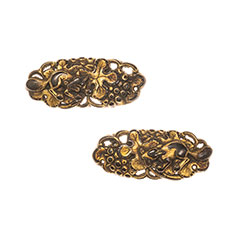
保存刀装具Hozon Tousougu
蝦夷 葡萄に栗鼠図目貫Ezo Budou-ni-Risuzu(Squirrels on grapes) Menuki
No.610206蝦夷 葡萄に栗鼠図目貫Ezo Budou-ni-Risuzu(Squirrels on grapes) Menuki
- 極めKiwame
- 蝦夷 Ezo
- 法量Size
-
表縦 1.83 cm 表横 4.21cm 表厚 7.4cm 表重量 4.0g 裏縦 1.84cm 裏横 4.18 cm 裏厚 7.4cm 裏重量 4.0g
OmoteLength 1.83 cm OmoteWidth 4.21cm OmoteThikess 7.4cm OmoteWeight 4.0g UraLength 1.84cm UraWidth 4.18 cm UraThikess 7.4cm UraWeight 4.0g
- 説明Drscription
- 山銅地 容彫 鍍金
蝦夷とは、蝦夷と汎称される、南北朝時代から室町前期時代にかけての装剣金工の一群。
彼らは、蝦夷金物と通称される装剣具を制作。その地金は白味かかるものから黒味がかる物まで山銅や四分一(銀と銅の合金)などを使用して、全体に金鍍金を施し、時代を経るに連れて剃り剥がしの古色溢れる独特な味わいのもとなっていく。Yamaganeji Katachibori Mekki(plating)
Ezo refers to a group of sword fittings from the Nanbokucho period through the early Muromachi period, collectively known as Ezo. They create sword accessories commonly known as Ezo Kanamono. The base metal ranges from whitish to blackish, and is made from Yamagane or Shibuichi (an alloy of silver and copper), and the entire piece is gold-plated, which over time develops a unique, patinated appearance that is reminiscent of sorihagashi.


